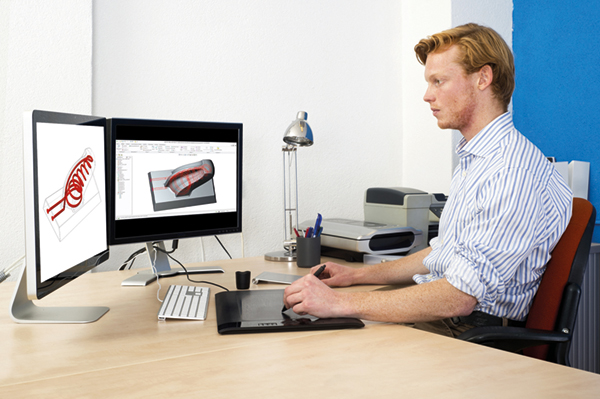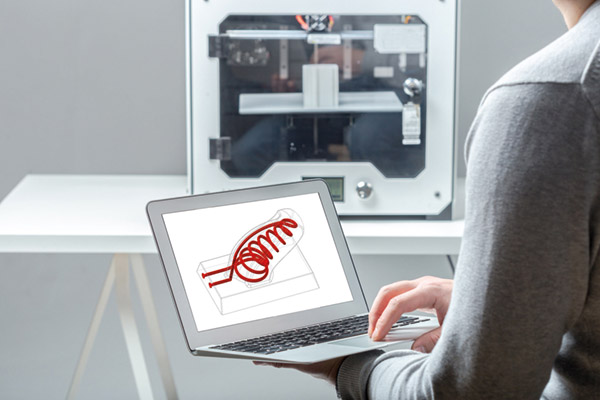
|
|
Developing smart products doesn't just require smart development tools, it also needs smart users who are capable of exploiting the intelligence offered by these tools and thus able to create smart product models. Otherwise, the digital twin will remain some kind of digital Frankenstein. Companies therefore need to sharpen their focus on design methodology. 
Design engineers no longer play a part in the brave new world of tomorrow's product development. Or at best they have been demoted to being mere assistants to computers, which create topologically optimized components on the basis of a few parameters. And these components are in turn produced with the aid of additive manufacturing processes. But the present is rather different: For years, PROSTEP's CAD specialists have been helping high-profile customers to develop their CAD models so intelligently that they can be quickly and flexibly adapted to new conditions or used for downstream processes such as CAE calculation. Many companies are paying dearly for the fact that they have neglected to provide their users with methodology training for years – if they haven't already outsourced design tasks to India or some other offshore paradise. For many years, companies have often been building 3D models without clear specifications and with the sole aim of deriving a production drawing. However, if we look towards additive manufacturing (AM) and the use of product manufacturing information (PMI) to establish drawing-free processes, the models must be correct and complete. New materials and additive manufacturing processes also change the way the models can be structured. The main benefit of AM lies in the greater range of possibilities for product design rather than in the manufacturing process. 
Rethinking product architectures Smart product models form the basis for end-to-end digitalization of business processes. They carry all the information relevant to production and service that is required in the later phases of the lifecycle. The digital master can be seen as the basis for the digital twin in the sense that it is a complete image of the delivered product configuration, and it can be brought to life using sensor data from the field. This understanding of the extended role of the model must be respected and taken into account when designing CAD models, otherwise the resulting digital twin will be on a shaky foundation. Companies must therefore invest more time and intelligence in building and validating their CAD models in order to minimize the amount of time and effort spent on making changes in subsequent development phases. High levels of product complexity and a wide range of variants, coupled with ever shorter development cycles and increasing cost pressure, are confronting companies with the challenge of fundamentally rethinking their product architectures. And this applies to the mechanical components in particular. They have to modularize their products more extensively in order to be able to respond rapidly to customer-specific requirements. They need to think about which components they may be able to combine and print or sinter from one piece using additive manufacturing processes. At the same time, AM also offers the possibility of designing the components using entirely different geometries in order to save material and weight. To achieve this, however, the models need to be designed in such a way that they can be simulated and optimized using CAE methods. Considerations such as additive manufacturing and the digital twin are forcing companies to think in even greater depth about how they build their digital product models in order to be able to use them throughout the process. Commercially available CAD systems such as PTC Creo or Siemens NX have for years offered a wide range of functions to embed manufacturing intelligence or information for computer-aided dimensioning in models, but these functions are rarely used in practice. However, the use of a parametric CAD system does not automatically result in smart product models. What makes a CAD model smart? For a CAD model, "smart" means that it fulfills its intended function, which naturally varies from component to component and can also change over the lifecycle. A company should establish uniform methods for recurring design tasks. A classic example is the use of associatively linked blank and finished part geometries for cast parts, making it possible to prepare the blanks for production and, to a certain extent, to update them at the touch of a button in the event of subsequent changes to the finished part. This works particularly well if the smart product model is built in such a way that the blank geometry is contained in the finished part geometry and can therefore be extracted without additional effort. If you want to produce a component with additive processes, you have to follow specific rules – in much the same way as with a model for a cast part. Mounting direction, wall thicknesses, component bevels and the depowdering of cavities are just a few examples. The models can have extremely complex geometries. Design engineers do not need to be production experts to build an optimum model, but they do need to be well versed in their CAD system. In addition to their actual job, which consists of producing a functioning product, design engineers are increasingly becoming service providers for downstream processes that require a functioning product model for their work. This is not fundamentally new, but it is becoming increasingly important with the digitalization of business processes. Companies have to take this into account when it comes to staffing levels in the design engineering departments on the one hand and the CAD training given to the design engineers on the other. The earlier the requirements of the downstream departments are taken into account, the more efficiently certain processes can be subsequently automated. Take this example as an illustration: The CAD specialists at PROSTEP parameterized the CAD model of an injection pipe, including the space around it, for a fluid dynamics simulation so intelligently that the simulation engineer was able to simulate dozens of different variants in quick succession and find the ideal geometry for the optimum gas/air mixture. To achieve this, the engineer was able to vary the defined parameters in the CAD model without actually being a CAD user. Although the gas and air flows were calculated using an external CAE tool, the key to success was the CAD model, which allowed all the variations to be mapped. As few references as possible Parametric modeling technology forms the basis for creating smart CAD models, but it has its drawbacks. Parametric models can only be changed very quickly if the desired changes were foreseen from the very start. Furthermore, it is sometimes difficult for other users to further develop their colleagues' models if there is no uniform way of working and methodology within the company. Understanding the design intent and the resulting dependencies in a model requires training, experience and ideally a uniform CAD methodology within the company. 
PROSTEP's CAD specialists propose a pragmatic approach to parameterization: As few cross-component references as possible, but as many as are necessary. Every click of the mouse can result in a reference that will make life difficult later on. That's why they pay attention to how we create each feature in the model. In order to be able to intelligently parameterize CAD models, all constraints such as installation space, geometric interfaces, preferred production method(s), expected modifications and variants, and simplification for subsequent processes must be clarified beforehand. If the constraints or design intentions change, the modifications should be inserted where they would have been inserted if they had been known beforehand. This keeps the CAD model lean and efficient. It may take weeks for a CAD model of a complex assembly to be built in such a way that it ultimately meets all the requirements of the downstream processes and can also be adapted quickly in case of changes, and iteration loops will be required. This amount of effort is not worthwhile for all components. Companies must therefore consider very carefully which product models are to be smart and exactly how smart they are to be. Particularly for products that are built in many customer-specific versions, systematic parameterization allows variants to be derived rapidly. If we consider the provision of digital twins of these variants, parameterization is absolutely essential. Businesses in Europe will only have a chance if they tackle these new challenges using the skills available to them. In order to do this, however, they must do more to skill up their designers. |
|
| © PROSTEP AG | ALL RIGHTS RESERVED | IMPRESSUM | DATENSCHUTZERKLÄRUNG | HIER KÖNNEN SIE DEN NEWSLETTER ABBESTELLEN. |

